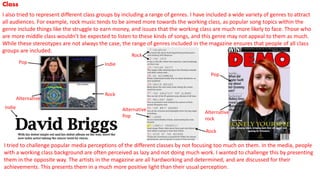The magazine represents various social groups through its content, imagery, and design choices. It features a diverse range of musical genres and artists to appeal to different tastes. Imagery includes people of various ages, genders, and social classes portrayed equally and challenging stereotypes. Price and layout aim to be accessible to teenagers and working-class readers. Color scheme and competitions aim to include different social groups without alienating others. The magazine aims to represent diversity and challenge limiting perceptions of social groups.









